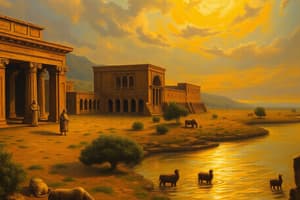Podcast
Questions and Answers
It is an arc of rich farmland that provided some of the best farming in Southwest Asia. It's curved shape and richness of land led scholars to call it the ____________ ________.
It is an arc of rich farmland that provided some of the best farming in Southwest Asia. It's curved shape and richness of land led scholars to call it the ____________ ________.
Fertile Crescent
The word Mesopotamia in Greek means 'land between the ____________.'
The word Mesopotamia in Greek means 'land between the ____________.'
rivers
What challenges did people face in Mesopotamia?
What challenges did people face in Mesopotamia?
Unpredictable flooding, lack of natural barriers for defense, and limited natural resources.
What was one solution for the problems faced in Mesopotamia?
What was one solution for the problems faced in Mesopotamia?
Each city and the land surrounding it became a -.
Each city and the land surrounding it became a -.
Who controlled the earliest governments in Sumer?
Who controlled the earliest governments in Sumer?
What is a dynasty?
What is a dynasty?
What is cultural diffusion?
What is cultural diffusion?
The Sumerians believed in more than one god.
The Sumerians believed in more than one god.
The Sumerians built impressive ziggurats for their gods and offered them rich sacrifices of animals, wine, and ____________.
The Sumerians built impressive ziggurats for their gods and offered them rich sacrifices of animals, wine, and ____________.
What social classes existed in Sumer?
What social classes existed in Sumer?
What were some of the inventions of the Sumerians?
What were some of the inventions of the Sumerians?
Flashcards are hidden until you start studying
Study Notes
Fertile Crescent
- An arc of rich farmland in Southwest Asia that provided excellent agricultural conditions.
- Encompasses lands facing the Mediterranean Sea and Mesopotamia, located between the Persian Gulf and Mediterranean Sea.
Mesopotamia
- Means "land between the rivers" in Greek, referring to the area between the Tigris and Euphrates rivers.
- Experienced annual flooding that deposited nutrient-rich silt for agriculture.
- Wheat and barley were the main crops resulting in significant harvest surpluses, allowing for village growth.
Problems in Mesopotamia
- Unpredictable flooding combined with dry periods led to desert conditions in some regions.
- Sumerian villages lacked natural defenses, making them vulnerable to attacks.
- Limited natural resources in Sumer made building materials and essential items scarce.
Solutions for Mesopotamian Problems
- Ditches for irrigation were dug to manage water supply and generate crop surpluses.
- City walls made of baked mud bricks were constructed for protection.
- Trade was established for raw materials like stone, wood, and metal in exchange for agricultural products.
City-state
- Each Sumerian city was independent, surrounded by agricultural fields, and governed separately.
- Examples include Uruk, Kish, Lagash, Umma, and Ur, which were often at war with one another from 3000-2000 BC.
Rulers in Sumer
- Initial governance was led by temple priests who were later supported by military leaders during conflicts.
- Military leaders often transitioned into full-time rulers, leading to dynasties where power was hereditary.
Dynasty
- A sequence of rulers from the same family lineage.
Cultural Diffusion
- The spread of ideas and products between cultures; Sumerians shared urban living concepts with neighboring societies.
Polytheism
- The Sumerian belief system, characterized by the worship of multiple gods, who controlled natural forces.
- Major deities included Enlil, the god of storms, and Ugallu, who protected against evil spirits.
Keeping Gods "Happy"
- Sumerians constructed large ziggurats and made sacrifices of animals, wine, and food to appease their gods.
Social Classes/Structure in Sumer
- Hierarchical structure included kings, landholders, priests, wealthy merchants, skilled laborers, and slaves.
- Women in Sumer had some rights, such as property ownership and participation in trade, and limited access to education.
Inventions of the Sumerians
- Innovations included the wheel, sail, cuneiform writing, the plow, and early bronze use.
- Development of arithmetic and geometry facilitated construction and irrigation management.
- Created a base-60 numerical system, arches, and columns in architecture.
Studying That Suits You
Use AI to generate personalized quizzes and flashcards to suit your learning preferences.




